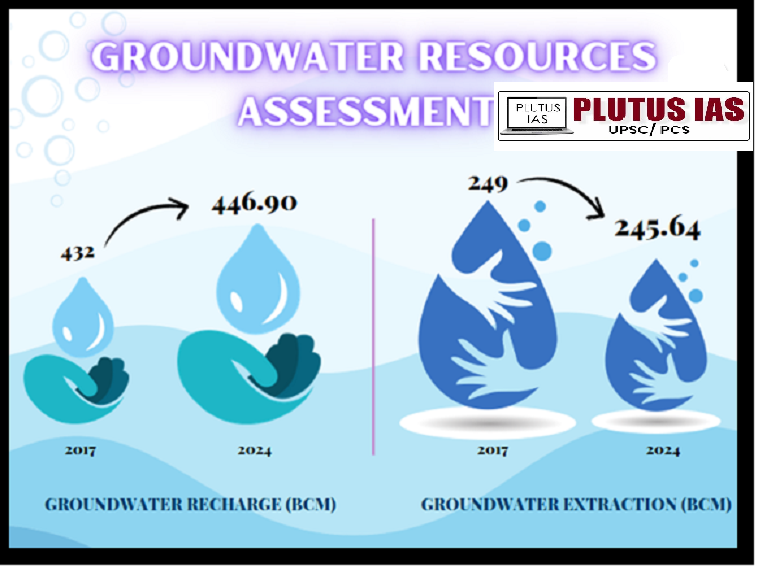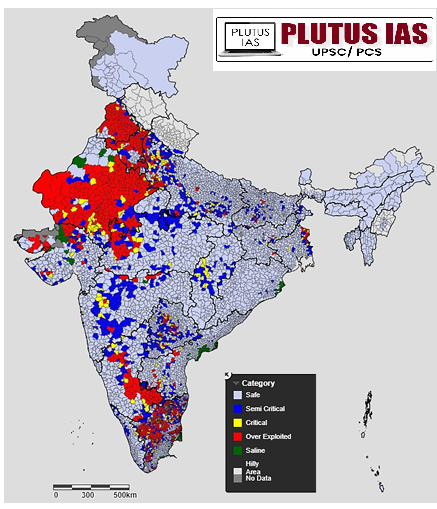09 Jan India’s Groundwater Revival: A Step Towards Sustainable Water Management
SYLLABUS MAPPING:
GS-3-Environment-India’s Groundwater Revival: A Step Towards Sustainable Water Management
FOR PRELIMS:
Key findings of the report and various govt measures and schemes to reduce groundwater depletion
FOR MAINS
major reason for groundwater depletion in india and sustainable practices to reduce it
Why in the news?
Groundwater has always been a critical resource, supporting life, agriculture, and communities worldwide. In recent news, a significant milestone has been reached in 2024, with groundwater recharge experiencing a remarkable increase of 15 billion cubic meters (BCM), while extraction has decreased by 3 BCM compared to 2017. This shift highlights positive progress in the sustainable management of groundwater, a resource often under pressure due to overuse and climate change. As global water demand continues to rise, understanding the balance between recharge and extraction is crucial. The increase in recharge signals an improvement in water conservation and management practices, reflecting a collective effort to safeguard this essential resource. However, challenges remain, including regional disparities, over-extraction, and the impact of droughts. This development has captured attention as it underscores the importance of sustainable water practices and the need to invest in technologies and policies that support the continued health of our groundwater supplies.

“We must adopt the mantra of ‘Reduce, Reuse, Recharge, and Recycle’ to secure the nation’s water future”-Prime Minister Shri Narendra Modi
Groundwater resources in India:
1. Annual Groundwater Recharge:India’s total annual groundwater recharge is 437.60 billion cubic meters (BCM).
2. Annual Groundwater Extraction: The total annual groundwater extraction stands at 239.16 BCM.
3. Extraction Stage:The average stage of groundwater extraction in India is 60.08%, meaning 60% of the available groundwater is being used.
4. Assessment Units:
India has 7,089 assessment units for groundwater.
1,006 units are over-exploited.
260 units are critical.
885 units are semi-critical.
4,780 units are safe.
5. Groundwater Sources: The replenishable groundwater resource is mainly replenished by rainfall and other sources like canal seepage, return flow from irrigation, and seepage from water bodies.
6. Groundwater Consumers:87% of the total annual groundwater extraction is consumed by agriculture, making it the largest consumer of groundwater in India.

Key finding of the report:
1. Increased Recharge:Groundwater recharge has risen by 15 BCM, reaching 446.90 BCM in 2024.
2. Reduced Extraction: Groundwater extraction has decreased by 3 BCM, totaling 245.64 BCM in 2024.
3. Improved Recharge from Tanks and WCS: Recharge from tanks, ponds, and water control systems increased by 0.39 BCM compared to 2023 and by 11.36 BCM since 2017.
4. Better Groundwater Conditions:
Safe category units increased from 62.6% in 2017 to 73.4% in 2024.
Over-exploited units decreased from 17.24% to 11.13%.
5. Improved Water Quality:The report highlights that 81% of groundwater samples are suitable for irrigation.
6. Positive Trends in Specific Regions:100% of groundwater samples from the northeastern states are rated “excellent” for irrigation.
7. Rising Recharge Potential:The continued increase in recharge from non-conventional sources like tanks, ponds, and WCS indicates sustainable water management practices.

Government initiative for groundwater survival:
1. Jal Shakti Abhiyan (JSA): A nationwide campaign aimed at water conservation, rainwater harvesting, and efficient water use. The “Catch the Rain” phase, launched in 2024, is part of this ongoing effort to promote water management at the local level.
2. Atal Bhujal Yojana (2020): Targets water-stressed regions in 80 districts across 7 states, focusing on improving groundwater management through community participation, efficient water usage, and capacity building.
3. Mission Amrit Sarovar (2022):Aim to rejuvenate or create 75 Amrit Sarovars (large water bodies) in every district, providing significant support for water harvesting and conservation efforts.
4. Pradhan Mantri Krishi Sinchai Yojana (PMKSY):Expands irrigation coverage and improves water use efficiency, particularly in agricultural sectors, through repair, renovation of water bodies, and irrigation system modernization.
5. National Aquifer Mapping (NAQUIM):Provides comprehensive mapping of India’s aquifers, helping to inform groundwater recharge and conservation strategies across over 25 lakh square kilometres.
6. Master Plan for Artificial Recharge to Groundwater (2020):Developed by the Central Groundwater Board (CGWB), this plan aims to create 1.42 crore rainwater harvesting and recharge structures to harness 185 BCM of rainfall annually.
7. Artificial Recharge Projects: Demonstration projects across various states show the feasibility of artificial recharge techniques, which can be replicated to restore groundwater levels.
8. National Water Policy (2012):Advocates for rainwater harvesting, water conservation, and augmentation of water availability through direct use of rainfall, providing a policy framework for sustainable water management.
9. Watershed Development Component of PMKSY (WDC-PMKSY):Focuses on soil conservation, rainwater harvesting, and livelihood development in rainfed and degraded lands, helping improve groundwater conditions in such areas.
Major reason for groundwater depletion:
1. Over-Extraction for Irrigation: The primary cause of groundwater depletion is excessive use for irrigation, especially in agriculture-dependent regions. Crop production, especially water-intensive crops like paddy and sugarcane, leads to unsustainable groundwater extraction.
2. Lack of Efficient Irrigation Systems:Widespread reliance on outdated, inefficient irrigation methods, such as flood irrigation, results in the wastage of water. The absence of modern techniques like drip or sprinkler irrigation exacerbates the depletion.
3. Urbanization and Population Growth: Rapid urbanization and increasing population demand more water for domestic and industrial use, leading to increased groundwater extraction, often beyond sustainable levels.
4. Industrial and Commercial Usage:Industries, especially in water-intensive sectors like textiles, chemicals, and beverages, heavily rely on groundwater, further contributing to depletion. Many industrial areas do not have sufficient alternative water sources.
5. Pollution and Contamination:Groundwater contamination from agricultural runoff, industrial waste, and improper disposal of sewage has made many aquifers unsafe for use. In many cases, the quality of available groundwater deteriorates, forcing deeper extraction.
6. Climate Change and Reduced Rainfall:Climate change has altered rainfall patterns, leading to droughts and reduced recharge of aquifers. Reduced rainfall and irregular monsoons diminish the natural replenishment of groundwater resources.
7. Poor Groundwater Management: Inefficient groundwater management practices, lack of regulation, and over-reliance on extraction without adequate recharge mechanisms have led to the depletion of aquifers. Insufficient awareness and poor enforcement of water conservation policies also play a role.
Way to reduce groundwater depletion in India:
1. Efficient Irrigation:Promote drip and sprinkler irrigation to minimize water wastage and optimize water use.
2. Rainwater Harvesting:Mandate and incentivize rainwater harvesting to recharge groundwater aquifers.
3. Water-Efficient Crops: Encourage drought-resistant and less water-intensive crops, reducing reliance on groundwater.
4. Groundwater Recharge: Implement artificial recharge techniques like check dams and infiltration ponds to replenish aquifers.
5. Regulation and Monitoring:Enforce stricter regulations on groundwater extraction and establish real-time monitoring systems.
6. Public Awareness:Educate communities on water conservation practices and sustainable usage.
7. Wastewater Recycling: Promote wastewater treatment and reuse, reducing dependency on groundwater for non-potable purposes.
Conclusion
Groundwater is vital for agriculture, industry, and daily life, but its depletion due to over-extraction and climate change remains a significant concern. Positive trends in recharge and reduced extraction in 2024 show progress, thanks to efforts like the Jal Shakti Abhiyan and Atal Bhujal Yojana. However, challenges persist, especially in over-exploited regions. To ensure sustainable groundwater use, India must focus on efficient irrigation, rainwater harvesting, wastewater recycling, and stricter regulations. Public awareness and adoption of water-efficient practices are crucial to securing groundwater for future generations.
Download Plutus IAS Current Affairs (Eng) 09th Jan 2025
Prelims Question:
1. The total annual groundwater recharge in India is 437.60 BCM.
2. Over-exploited groundwater units have increased in recent years.
3. The increase in groundwater recharge in 2024 is 15 BCM compared to 2017.
4. Groundwater extraction for agriculture accounts for 87% of the total annual extraction in India.
Choose the correct option given below:
A. Only 1 and 3
B. 1, 2, and 4
C. 1 and 4
D. 1, 2, and 3
Answer: B
Mains Question:
(250 words, 15 marks)




No Comments